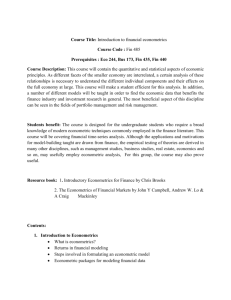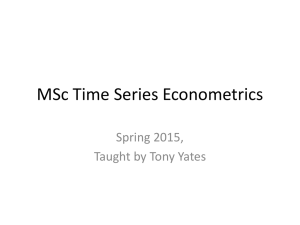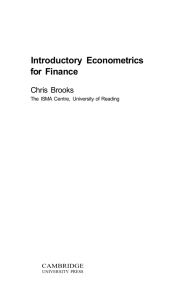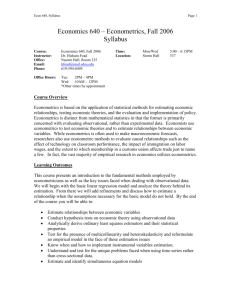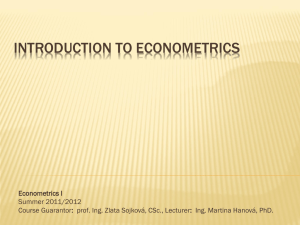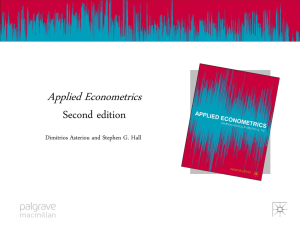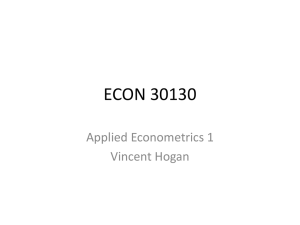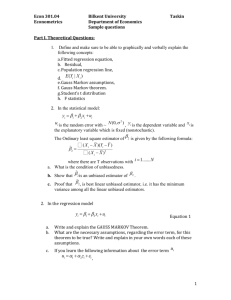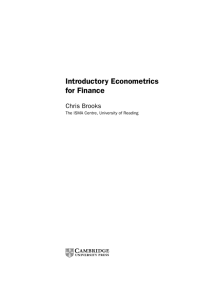term paper general guidelines
advertisement
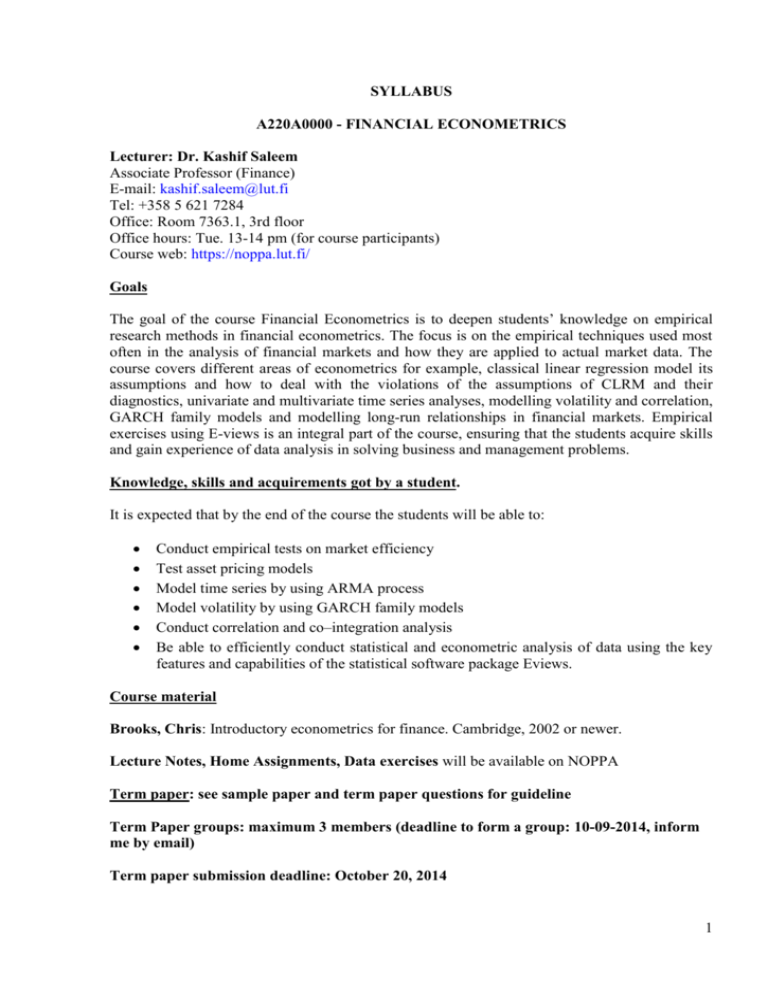
SYLLABUS A220A0000 - FINANCIAL ECONOMETRICS Lecturer: Dr. Kashif Saleem Associate Professor (Finance) E-mail: kashif.saleem@lut.fi Tel: +358 5 621 7284 Office: Room 7363.1, 3rd floor Office hours: Tue. 13-14 pm (for course participants) Course web: https://noppa.lut.fi/ Goals The goal of the course Financial Econometrics is to deepen students’ knowledge on empirical research methods in financial econometrics. The focus is on the empirical techniques used most often in the analysis of financial markets and how they are applied to actual market data. The course covers different areas of econometrics for example, classical linear regression model its assumptions and how to deal with the violations of the assumptions of CLRM and their diagnostics, univariate and multivariate time series analyses, modelling volatility and correlation, GARCH family models and modelling long-run relationships in financial markets. Empirical exercises using E-views is an integral part of the course, ensuring that the students acquire skills and gain experience of data analysis in solving business and management problems. Knowledge, skills and acquirements got by a student. It is expected that by the end of the course the students will be able to: Conduct empirical tests on market efficiency Test asset pricing models Model time series by using ARMA process Model volatility by using GARCH family models Conduct correlation and co–integration analysis Be able to efficiently conduct statistical and econometric analysis of data using the key features and capabilities of the statistical software package Eviews. Course material Brooks, Chris: Introductory econometrics for finance. Cambridge, 2002 or newer. Lecture Notes, Home Assignments, Data exercises will be available on NOPPA Term paper: see sample paper and term paper questions for guideline Term Paper groups: maximum 3 members (deadline to form a group: 10-09-2014, inform me by email) Term paper submission deadline: October 20, 2014 1 Teaching methods Lectures 16 h, Data Exercises 8 h Grading Graded 0–5 on the based on 70% exam and 10% home assignments 20% Term paper. Prerequisites Compulsory B.Sc. courses in Finance (except completed Bachelor’s thesis). In particular, it is required that students have understanding of financial terms and analysis. Timetable: week 37 - Monday - September 08 - 13:00 - 16:00 - Room No. 7334--------- Chapter:1+2 week 37 - Wednesday - September 10 - 13:00 - 16:00 - Room No. 7334----- Chapter:2 week 38 - Monday - September 15 - 13:00 - 16:00 - Room No. 7334----------Chapter:3 week 38 - Wednesday - September 17 - 13:00 - 16:00 - Room No. 7334------Chapter:4 week 39- Monday - September 22- 13:00 - 16:00 - Room No. 7334------------Chapter:5 week 39 - Wednesday - September 24 - 13:00 - 16:00 - Room No. 7334-------Chapter:6 week 40- Monday - September 29 - 13:00 - 16:00 - Room No. 7334------------Chapter:7 week 40- Wednesday - October 01- 13:00 - 16:00 - Room No. 7334------------Chapter:8 Structure and content of academic studies Class 1&2 Topic 1. Introduction and a brief overview of the classical linear regression model. Introduction What is econometrics? Types of data Steps involved in formulating an econometric model Points to consider when reading articles in empirical finance A brief overview of the classical linear regression model What is a regression model? Regression versus correlation Simple regression The assumptions underlying the classical linear regression model Properties of the OLS estimator Precision and standard errors An introduction to statistical inference A special type of hypothesis test: the t-ratio Empirical data exercises with Eviews Reading: Brooks, Chris: Introductory econometrics for finance. Cambridge, 2002 or newer Ch. 1&2 Learning objectives and outcomes: Understand econometrics, key steps involved in econometric modeling; 2 understand the basics of univariate CLRM with interpretation of regression results; understand the kinds of data sets that are used in business, economics, and finance. Home assignment: Data Exercise 1. Class 3 Topic 2. Further development and analysis of the classical linear regression model. Generalising the simple model to multiple linear regression Testing multiple hypotheses: the F-test Data mining and the true size of the test Goodness of fit statistics components analysis Empirical data exercises with Eviews Reading: Brooks, Chris: Introductory econometrics for finance. Cambridge, 2002 or newer Ch. 3 Learning objectives and outcomes: Understand the multiple linear regression model; interpret the slopes and constant term. Understand the use of F-test, size of the test, Goodness of fit statistics and components analysis Home assignment: Data Exercise 2. Class 4 Topic 3. CLRM assumptions and diagnostic tests Tests for Heteroscedasticity Tests for autocorrelation Multicollinearity Testing for departures from normality Parameter stability tests Empirical data exercises with Eviews Reading: Brooks, Chris: Introductory econometrics for finance. Cambridge, 2002 or newer Ch. 4 Learning objectives and outcomes: Understand the assumptions, violation of the assumptions and 3 diagnostic tests of CLRM. Home assignment: Data Exercise 3. Class 5 Topic 4. Univariate time series modelling and forecasting. Moving average processes Autoregressive processes The partial autocorrelation function ARMA processes Building ARMA models: the Box--Jenkins approach Exponential smoothing Forecasting in econometrics Empirical data exercises with Eviews Reading: Brooks, Chris: Introductory econometrics for finance. Cambridge, 2002 or newer Ch. 5 Learning objectives and outcomes: Understand the Univariate time series modelling, such as ARMA models and forecasting using Univariate time series models. Home assignment: Data Exercise 4. Class 6 Topic 5. Multivariate models. simultaneous equations models exogeneity Vector autoregressive models Block significance and causality tests VARs with exogenous variables Impulse responses and variance decompositions Empirical data exercises with Eviews Reading: Brooks, Chris: Introductory econometrics for finance. Cambridge, 2002 or newer Ch. 6 Learning objectives and outcomes: Understand the Multivariate time series modelling, such as simultaneous equations models and Vector autoregressive models 4 Home assignment: Data Exercise 5. Class 7 Topic 6. Modelling long-run relationships in finance. Stationarity and unit root testing Cointegration Equilibrium correction or error correction models Johansen Cointegration technique based on VARs Empirical data exercises with Eviews Reading: Brooks, Chris: Introductory econometrics for finance. Cambridge, 2002 or newer Ch. 7 Learning objectives and outcomes: Understand how to model, estimate and interpret relationships between two variables in the long run by using different Cointegration models Home assignment: Data Exercise 6. Class 8 Topic 7. Modelling volatility and correlation. Models for volatility Autoregressive conditionally heteroscedastic (ARCH) models Generalised ARCH (GARCH) models Extensions to the basic GARCH model Uses of GARCH-type models including volatility forecasting Multivariate GARCH models Empirical data exercises with Eviews Reading: Brooks, Chris: Introductory econometrics for finance. Cambridge, 2002 or newer Ch. 8 Learning objectives and outcomes: Understand how to model, estimate and forecast volatility and correlation Home assignment: Data Exercise 7. 5 TERM PAPER GENERAL GUIDELINES: FINANCIAL ECONOMETRICS TERM PAPER GENERAL GUIDELINES Language of the paper: The language of the paper is English. Length of the paper: The recommended length for the term paper is a cover page plus 10-15 pages including references. Plus appendices. Deadline for submission: Send your final term paper in one file either in Adobe pdf or MS Word format. Dead line for term papers is 20-10-2014. Send by email. (Kashif.saleem@lut.fi) TERM PAPER - RESEARCH TOPICS 1 1. CAPM type questions… how market risk effect of stock prices – univariate CLRM 2. APT type questions … how different macro factors, such as Int, fx,inf,etc. effect on stock prices – Multivariate CLRM 3. Modeling any class of assets returns…. Stock, bond, derivatives, commodities…..ARMA process - univariate 4. Modeling any class of assets returns …. Stock, bond, derivatives, commodities…..VAR process – Multivariate 5. Modeling long run relationship between two assets or variables (macro) ---Co integration test 6. Modeling volatility of a single asset ….Univariate GARCH 7. Checking the leverage effect …EGARCH, GJR 8. Checking the relationship of two variables, assets volatility ---Multivariate GARCK Models 9. Spillover effects, contagious effect, how the markets are integrated ---BEKK model TERM PAPER STRUCTURE COVER PAGE LIST OF CONTENTS INTRODUCTION Describe briefly the topic of your term paper Story, Motivation, research question see, term paper questions 2 LITERATURE REVIEW What kind of theories/theoretical / empirical framework different authors have used to deal with the topic of your research? try to find mixed results in the previous published work, for example, at least - one paper supporting expected results, one paper showing contrary to the expected results and one paper showing mixed results, to justify your contribution. 3 EMPIRICAL FRAMEWORK Describe briefly the methods you proposed to analyze the topic of your term paper 6 For example, ARIMA family models, VAR method, Johnson Co-integration technique, GARCH family models 4 DATA Describe the characteristics of your data: graphically, Descriptive statistics ( mean, SD, Skewness, Kortosis, ADF, LM test, JB test, etc…) 5 RESULTS What were the main findings of the research papers? What are the implications of the research? How do you think that this research could be useful to investors, portfolio managers, companies, etc… 6 CONCLUSION What kind of extension on the research you could imagine on this topic? . How this term paper has increased your knowledge of the particular topic What are the strengths and weaknesses of the research papers? Why? REFERENCES 7

